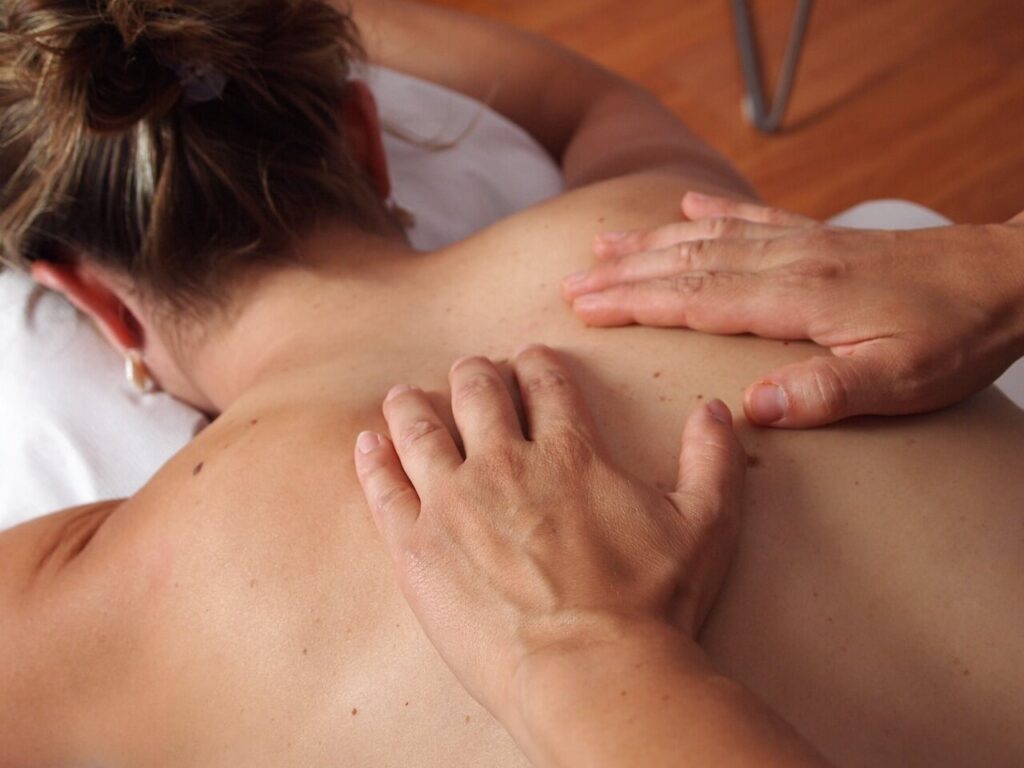Are tight, sore muscles disrupting your life? You may want to give myofascial release a try.
Myofascial release therapy (MRT) is a massage technique that targets fascia, your body’s connective tissues. Fascia provides structure for your body, helps your muscles and tendons move, and holds your body together.
So, when restrictions form in the fascia, it can disrupt your entire body. These restrictions, known as “trigger points,” act like a roadblock, preventing blood, lymphatic fluid, and oxygen from flowing freely. This can lead to pain and discomfort and restrict movement.
That’s where myofascial release therapy comes in. Also called trigger point therapy, this form of massage stretches the myofascial tissues. This helps restore mobility and reduce pain and discomfort.
Wondering if it may be a good fit for you? Keep reading to learn how myofascial release therapy works.
What is Fascia?
Fascia, short for myofascial tissue, is a stretchy web of connective tissue that spreads throughout your body. It wraps your organs, muscles, bones, nerves, joints, tendons, and ligaments, and holds them in place.
Your fascia appears like a single sheet of tissue. But it’s made up of several layers. Between each layer is hyaluronan, a liquid that helps fascia stretch and move freely.
However, certain factors can cause this liquid to become thick or sticky. This could happen due to:
- Poor posture
- Physical inactivity
- Dehydration
- Overworking one part of the body
- Trauma such as an injury or illness
As the fascia dries up, it loses its flexibility. This can lead to muscle tightness and restrict movement. But it can also cause painful knots to develop in the myofascial tissue, called trigger points.
How Does Myofascial Release Therapy Work?
The goal of myofascial release therapy is to stretch and lengthen the fascia. This can help release pain and tightness and restore range of motion.
Many trained practitioners provide myofascial release therapy, including:
- Massage therapists
- Chiropractors
- Physical therapists
- Sports medicine specialists
- Osteopathic physicians
At Anchored in Health, we’re fortunate to have a massage therapist and a chiropractor trained in myofascial release.

During a session, your massage therapist feels for any stiff or tight areas in the fascia. These tense spots are known as trigger points, or “knots.” Once located, they apply gentle pressure kneading and stretching your fascial tissues.
Unlike other forms of massage, no oils or lotions are used in myofascial release. This allows your massage therapist to better feel the stiff spots in your fascia. They gently massage those areas until they feel the tightness release.
Sometimes the process must be repeated multiple times on the same trigger point to fully release the tension.
Benefits of Myofascial Release Therapy
Many studies explore the benefits of massage therapy. Yet few have focused on myofascial release in particular. This is partly because techniques can vary so much from practitioner to practitioner.
Still, myofascial release therapy comes with many potential health benefits, including:
- Reduced pain
- Improved range of motion
- Increased blood flow
- Stress relief
- Relaxation

According to the Cleveland Clinic, myofascial release therapy may help several health conditions, including:
- Myofascial pain syndrome: A chronic pain condition that causes pain in your muscles and surrounding tissues.
- Low back pain: Low back pain occurs when you strain the muscles or tendons in your back. This can cause pain and reduce range of motion. It’s the leading cause of disability worldwide.
- Fibromyalgia: A chronic condition that causes widespread musculoskeletal pain, fatigue, and sleep issues.
- Carpal tunnel syndrome: This nerve condition is marked by numbness, tingling, or weakness in the wrist or hand. It happens due to a pinched nerve in the wrist.
- Temporomandibular joint and muscle disorders (TMJ): A common condition that causes pain and inflammation in the jaw and surrounding muscles.
- Chronic migraine: A neurological disorder that causes throbbing, one-sided headaches, amongst other symptoms.
Keep in mind that this list is not exhaustive. Myofascial release may benefit many other ailments as well, such as neck and shoulder pain. The only way to know if it can help you is to try it out!
Can You Perform Myofascial Release Therapy on Yourself?
Yes, you sure can. You can perform self-myofascial release, a form of self-massage, using tools like foam rollers or tennis balls.

To do this, simply place a roller or ball in a target area and roll back and forth until you find a tender spot.
Once you find one, hold it there. Relax and breathe until you feel the tension ease. This may take anywhere between 30 seconds to a couple of minutes. Then, move on to the next spot and repeat the process.
Some people prefer a massage therapist to show them the ropes of myofascial release for the first time. But there are also demo videos online that can walk you through it.
Here are a few:
- Simple 2-minute myofascial release demo to learn the basics
- 2-minute foam rolling demo for thoracic spine
- 9-minute myofascial release routine using a ball
Risks of Myofascial Release
Like other forms of massage, there are few risks to myofascial release therapy.
That said, myofascial release isn’t a good fit for everyone. It’s not recommended for certain health conditions, including:

- Bone fractures
- Open wounds
- Deep vein thrombosis
- Metabolic disorders
- People taking blood thinners
Just like all forms of massage, you may feel some detox symptoms after myofascial release. This may include soreness, light bruising, headaches, dizziness, or fatigue.
Rest assured, any discomfort should subside fairly quickly. To reduce the risk of these symptoms, be sure to drink plenty of water following myofascial release.
What Other Treatments Work Well With Myofascial Release?
Myofascial release therapy can be used as a standalone tool for pain relief. But it may also enhance the effectiveness of other alternative treatments, including:
- Chiropractic care: Chiropractic treatments get the spine and joints in proper alignment. This can, in turn, reduce pressure on the fascia and surrounding muscles.
- Acupuncture: Acupuncture reduces pain and restores balance in the body, which may speed recovery. Plus, it promotes relaxation, which may help release tension in the fascia.
- Physical therapy: Physical therapists design exercise routines to improve strength, mobility, and posture. This can help keep the fascia flexible.
- Yoga: Yoga stretches the fascia to help keep it supple and flexible. This may increase range of motion and enhance the results from myofascial release.
How Long Does It Take to Work?
Like all forms of massage, myofascial release works best when done consistently.
That said, some people may experience benefits from a single myofascial release massage. Others may need several massages over weeks or months to see long-term relief.
Get Relief With Myofascial Release Therapy From A Massage Therapist in Orland Park, IL
If you live in the Chicago area and are tired of pain interfering with your life, Anchored in Health is here to help.
Our massage therapist and chiropractor are both experts at myofascial release. If you’re ready to say goodbye to your pain and discomfort and feel better, follow these steps:
- Contact us with questions.
- Book your first myofascial release therapy massage here.
- Discover how myofascial release can help relieve pain, ease tension, and restore mobility.
Other Health and Wellness Services Offered at Anchored in Health at Orland Park, IL
At Anchored in Health, we offer many holistic health services to support your well-being. This includes chiropractic care, acupuncture, functional medicine, and the Shape ReClaimed program. We also offer thermography and genetic testing to help you learn important insights about your health.
Contact us to find out how we can help you live a healthier, happier life! And visit our blog for more helpful health tips.
Disclaimer: The information provided on this blog is for educational and informational purposes only and is not intended to diagnose, treat, cure, or prevent any disease. The content is not a substitute for professional medical advice, diagnosis, or treatment. Always seek the guidance of a qualified healthcare provider with any questions you may have regarding your health or a medical condition.
Reading this blog does not establish a doctor-patient relationship between you and Anchored In Health or any of its practitioners. Reliance on any information provided in this blog is solely at your own risk. For medical concerns, always consult a licensed healthcare provider.
